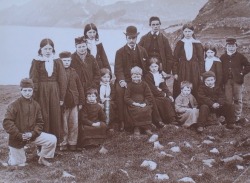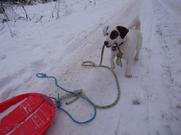
We received a postcard from my parents the other day, all the way from St. Kilda, a remote island off the north-west coast of Scotland. It brought a lump to my throat to look at the faces in this group portrait of the island scoolmaster, George Murray, and his pupils taken in 1886. After years of living in China, to see the blond (or red?) hair, these so-Scottish faces earnestly looking at the camera brought on a wave of homesickness. The postcard, with its unique St.Kilda puffin franking, was posted in the NTS shop on the island and subsequently helicoptered into the mail system at Benbecula. Amazingly it only took a few days (rather than weeks) to reach us here in SW China. In the past, the inhabitants of St. Kilda employed a a far more hit-and-miss method of sending messages to the outside world - the famous St. Kilda mailboat. This was a watertight container attached to a sheepskin bladder, launched into the ocean whenever the wind blew from the NW. Amazingly, 2/3 of these actually turned up on the mainland.

The St. Kilda archpelago is situated 64 kilometres (40 mi) west-northwest of North Uist and is the most remote of Scotland's Outer Hebridean Islands, in the North Atlantic Ocean. St Kilda was permanently inhabited for at least two millennia though the entire population was evacuated in 1930. Currently, the only residents are military personnel. Living on the islands in the past was a punishing experience. The residents' diet consisted mainly of seabirds - gannets, puffins and fulmars are abundant - (and their eggs) supplemented by barley and potatoes. Growing these crops in the harsh climate was bad enough, but getting hold of the birds was even more tricky, and often involved climbing the sheer cliffs on which they nested. St Kilda was made a World Heritage Site in 1986, and is one of the few in the world to be granted this status on both natural and cultural grounds.

 RSS Feed
RSS Feed